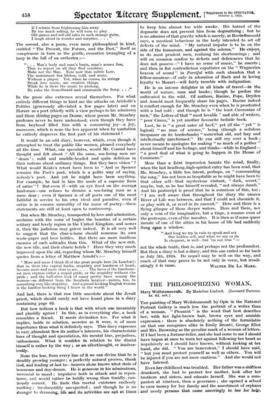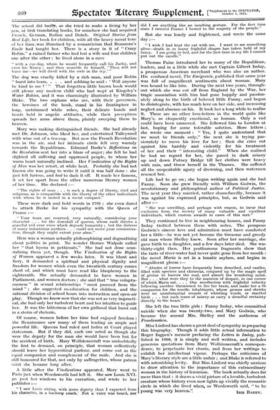THE PHILOSOPHIZING WOMAN.
Mary Wollstoneeraft. By Madeline Linford. (Leonard Parsons. 4e. 6d. net.) THE painting of Mary Wollstonecraft by Opie in the National Portrait Gallery is much less the portrait of a writer than of a woman. " Pleasant " is the word that best describes her, with her light-brown hair, brown eyes and amiable expression : there is absolutely nothing of the formidable air that one recognizes alike in Emily Brontë, George Eliot and Mrs. Browning as the peculiar mark of a woman of letters. If I had been a fortune-teller, and she had come to me I should have begun at once to warn her against following her heart as impulsively as I should have known, without looking at het hand, she did. " You are benevolent," I should have said, " but you must protect yourself as well as others. You will be injured if you are not more cautious." And she would not have listened.
Even her childhood was troubled. Her father was a shiftless drunkard, she had to protect her mother, look after her brothers and sisters, and educate herself. She was a com- panion at nineteen, then a governess ; she opened a school to earn money for her family and the assortment of orphans and needy persons that came unerringly to her for help.
The school did badly, so she tried to make a living by her
pen, at first translating books, for somehow she had acquired French, German, Italian and Dutch. Original Stories from Real Life, her book for children, with all the heavy moral tone of her time, was illumined by a romanticism that Rousseau's Emile had taught her. There is a story in it of " Crazy Robin," a ruined fanner who had lost a wife and four children one after the other : he lived alone in a cave
" with a cur-dog, whom he would frequently call his Jacky, and even his Nancy ; and then mumble to himself, Thou wilt not leave me—we will dwell with the owls in the ivy.' "
The dog was cruelly killed by a rich man, and poor Robin " burst into tears, . . . and sobbing he said : ' Will anyone be kind to me ? ' " That forgotten little brown book would
still please any modern child who had wept at Kingsley's Water Babies, and it was charmingly illustrated by William Blake. The two orphans who are, with their governess, the heroines of the book, stand in his frontispiece in
long, untrimmed white robes, their delicate hands and heads held in angelic attitudes, while their preceptress spreads her arms above them, plainly sweeping them to heaven.
Mary was making distinguished friends. She had already met Dr. Johnson, who liked her, and entertained Talleyrand with wine out of a tea-cup. But now the French Revolution
was in the air, and. her intimate circle felt very warmly towards the Republicans. Edmund I3urke's Reflections on the Revolution sent her into a blaze of anger ; she felt he had slighted all suffering and oppressed people, to whom her warm heart naturally inclined. Her Vindication of the Rights of Man was her retort, at white heat.. Probably she had not known she was going to write it until it was half done : she just felt furious, and had to dash it off. It made her famous, it 'set her apart from the other numerous literary women of her time. She declared :- " The rights of man . . . is such a degree of liberty, civil and religious, as is compatible with the liberty of the other individuals with whom he is united in a social compact."
These were dark and bold words in 1791 : she even dared to attack Burke for his sympathy with the Queen of France :— - - -
" Your tears aro reserved, very naturally, considering your character . . . for the downfall of queens, whose raiik throws a graceful veil over vices which degrade humanity ; but the distress of many industrious mothers . . . could not move your commisera- tion, though they might extort your alms."
Here was a woman actually philosophizing and dogmatizing about politics in print. No wonder Horace Walpole called
her " that hyena in petticoats." She had not done scan- dalizing them yet, though. The Vindication of the Rights of Woman appeared a few weeks later. It was blunt and
fiery, it demanded a spiritual and physical dignity and freedom for women which even the twentieth century comes short of, and which must have read like blasphemy to the eighteenth. She actually demanded to have women in Parliament, and women doctors ; she said that " true voluptu- ousness " in sexual relationships " must proceed from the mind " ; she suggested co-education for children, and the rational division of school hours into instruction and open-air play. Though we know now that she was not so very impracti- cal, she had only her turbulent heart and her intuition to guide her. It was the bitterness of her own girlhood that burst out in a storm of rhetoric.
• Of course, women before her time had enjoyed freedom : the Renaissance saw many of them leading an ample and
powerful life. Queens had ruled and one at Court played
statesman. But if they did, each 'one acted as though she were the deputy for the man she would have been but for the accident of birth. Mary Wollstonecraft was undoubtedly. the first to demand, on principle, that woman collectively should leave her hypocritical parlour, and come out as the equal companion and complement of the male. And she is still honoured for that, not only by suffragettes, whose patron saint she became long after.
A little after the Vindications appeared, Mary went to Paris just when Wordsworth had left it. She saw Louis XVI.
go past her windows to his execution, and wrote to her publisher :—
"I saw Louis sitting, with more dignity .than I expected from
.
his character, in a hackney edach." Not a voice was heard, 'nor
■ .■
did I see anything like an insulting gesture. For the first time since I entered Franco I bowed to the majesty of the people."
But she was lonely and frightened, and wrote the same day :— " I wish I had kept the cat with me. I want to see something alive—death in so many frightful -shapes has taken hold of my fancy. I am going to bed, and for the first time in my life I cannot put out the candle."
Thomas Paine introduced her to many of the Republican, leaders, and in a little while she met Captain Gilbert Imlay, a prosperous American merchant who was also an author. His confused novel, The Emigrants, published that same year
was full of magnificent sentiments about woman. Mary was bound to like him. During the next two years, through-
out which she was cut off from England by the War, her tragic association with him had gone happily and passion- ately along to the birth of beloved little Fanny, and begun to disintegrate, with too much love' on her side, and increasing neglect and absence on his. It took her a long while to realize it. There are no other love-letters in the world quite like Mary's, so eloquently emotional, so human. Only a cad could have been unmoved. She followed him to London at last, hoping for some tolerable solution. More letters ; she wrote one moment : " Yes, I quite understand that we must be friends only," the next she is trying pas-, sionately to move his love . for her ; then she cries out against him harshly and violently for his treatment of her and their " interesting child." When she realized he had no regard for her, she - paced in dark misery up and down Putney Bridge till her clothes were heavy with rain, and threw herself in. the Thames. She suffered all the unspeakable agony of drowning, and then watermen rescued her.
Life had to go on ; she began writing again and she had Fanny. Soon she grew friendly with William Godwin, the revolutionary and philosophical author of Political Justice.
The next year they married, rather shamefacedly, because it was against his expressed principles, but, as Godwin said after :--
" She was unwilling, and perhaps with reason, to incur that exclusion from the society of many valuable and excellent individuals, which custom awards in cases of this sort."
They continued to live in neighbouring houses, and Fanny Imlay trotted between them with notes. The pompous Godwin's sincere love and admiration must have comforted her a little—he was not yet become the tiresome and greedy old man whom Shelley knew. Soon after her marriage; she
gave birth to a daughter, and a few days later died. She was thirty-eight then. Her posthumous fragments show that the taste of river-water-had never quite gone from her mouth : the novel Maria is set in a lunatic asylum, and begins in
magnificent gloom
" Abodes of horror have frequently been described, and castles, filled with spectres and chimeras, conjured up by the magic spell of genius to harrow the soul, and absorb the wondering mind. But . . . what were they to the mansion of despair, in one corner of which Maria sat. . . . One recollection with frightful velocity following another threatened to fire her brain, and make her a fit companion for the terrific inhabitants, whose groans and shrieks were no unsubstantial sounds of whistling winds, or startled birds . . . but such tones of misery as carry a dreadful certainty directly to the heart."
She left the two little girls : Fanny Imlay, who committed suicide when she was twenty-two, and Mary Godwin, who became the second Mrs. Shelley and the authoress of Frankenstein.
Miss Linford has shown a great deal of sympathy in preparing this biography. Though it adds little actual information to Roger Ingpen's memoir prefacing the Letters to Imlay, pub- lished • in 1908, it is simply and well written, and includes
generous quotations from Mary Wollstonecraft's correspon- dence, to perpetuate her charm, and from her writings to exhibit her intellectual vigour. Perhaps the criticisms of Mary's literary style are a little unfair ; and Blake is referred to with astonishing levity. But Miss Linford was chiefly anxious to draw attention to the importance of this extraordinary woman in the history of feminism. The book actually does far more than that : it draws a vivid picture of a lovable, turbulent creature whose history even now lights up vividly the romantic circle in which she lived when so Wordsworth said, " to be



















































 Previous page
Previous page